How Much Do Spotify and Other Streaming Services Pay Per Stream?
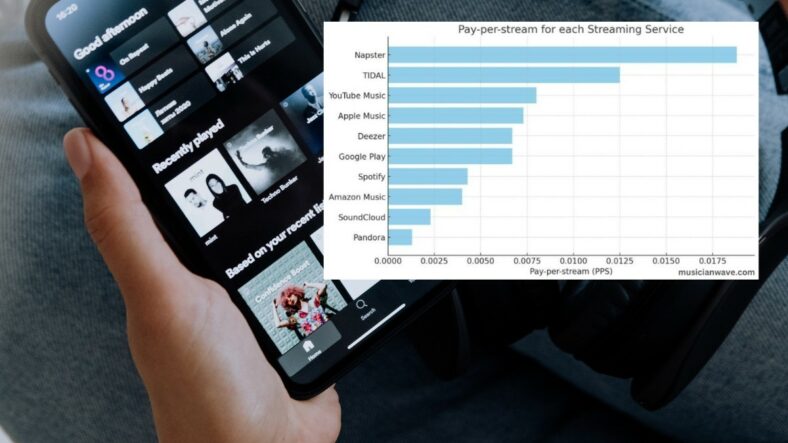
Spotify pays an estimated average of $0.0043 per stream, but their pay-per-stream (PPS) can be as high as $0.0084. The PPS of alternative streaming services varies between $0.0188 (Napster) and $0.0013 (Pandora). PPS values aren’t always exact, as they can be influenced by factors such as location.
While it’s hard to determine exactly what the PPS of Spotify and other streaming services is, some music distribution websites provide helpful guideline figures for determining how much each streaming service pays per stream. The values in the table below are listed in U.S. dollars and estimated according to the U.S. market.
How much do streaming services pay per stream?
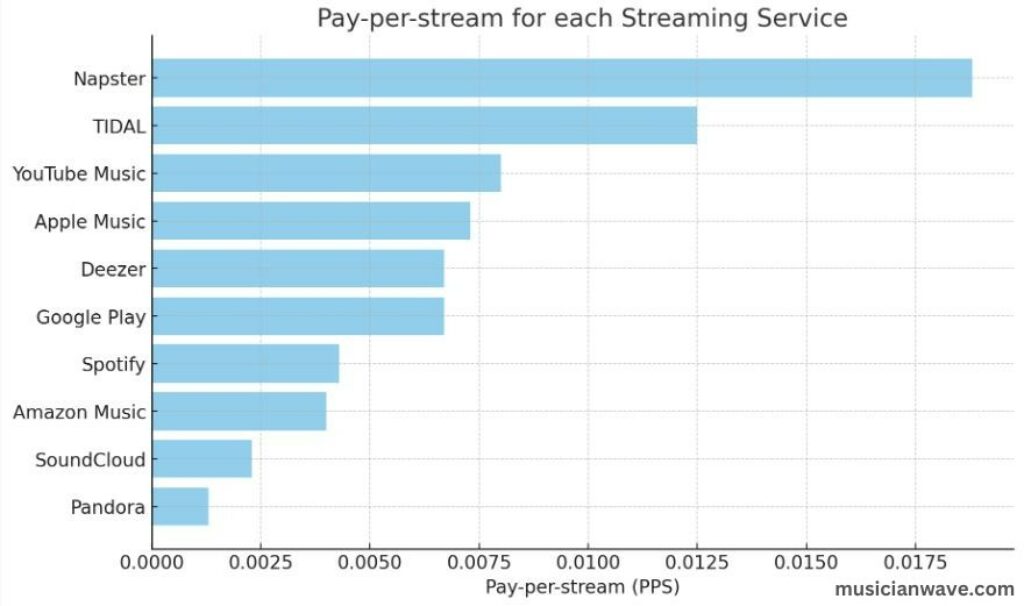
| Streaming service | Pay-per-stream (PPS) | Streams needed to make $1 |
| Napster | $0.0188 | 53 |
| TIDAL | $0.0125 | 80 |
| YouTube Music * | $0.0080 | 125 |
| Apple Music | $0.0073 | 136 |
| Deezer | $0.0067 | 148 |
| Google Play | $0.0067 | 148 |
| Spotify | $0.0043 | 229 |
| Amazon Music | $0.0040 | 249 |
| SoundCloud | $0.0023 | 435 |
| Pandora | $0.0013 | 750 |
Note: YouTube Music should not be confused with YouTube, which pays content creators per view, not per stream. With regular YouTube, creators get approximately $0.0006 per view, meaning they need to reach 1,456 views to make $1.
Data sources:
Ditto Music
Music Gateway
RouteNote

Napster appears to be the highest paid streaming service around, and one of just two of the most popular streaming services that reward artists with more than one cent per stream. On the other side of the spectrum, an artist needs to hit a whopping 750 streams to make $1 on Pandora and over 400 streams to get the same amount on SoundCloud.
Contents
- Which factors can influence streaming services’ payments?
- What counts as a stream?
- How do streaming services make money?
- How and why can bigger artists get a better pay-per-stream deal with Spotify and other streaming services?
- How does the money flow in the music-streaming industry?
- What’s the world’s most popular streaming service?
- Who’s the world’s most popular streaming artist?
- How can artists increase their earnings from streaming services?
- Which countries pay the most per stream?
- Summary
Which factors can influence streaming services’ payments?
Four main factors can influence how much an artist is paid per stream: the streaming service, the listeners’ location, the listeners’ subscription package, and the specific rates agreed by artists, labels, and music distribution companies.
1. Streaming service
Artists can get paid more or less depending on the streaming services they use. As established, PPS values can vary drastically between $0.0188 and $0.0013 depending on the streaming platform. If we take into account the 10 most popular streaming services in the world, the average collective PPS value sits around $0.0071.
2. Listeners’ location
Average PPS values can also vary drastically from country to country. According to the digital music distribution platform iGroove Music, PPS numbers can go from a collective average of $0.0178 (South Korea) to a collective average of $0.0005 (Turkey). You can find more information on how listeners’ location influences PPS values here.
3. Listeners’ subscription package
Popular streaming services such as Spotify reward artists with a higher PPS for streams made by subscribed listeners. Because Spotify and many other streaming services are subscription-based companies, their PPS for subscribed users is higher than their PPS for free users.
4. Specific deals
Streaming money flows in intricate ways. Major artists are extremely valuable for streaming services, so they may get better deals and have higher PPS values than independent artists. The amount of money that artists ultimately get paid per stream is also dependent on their record-label deal and digital music distribution company.
What counts as a stream?
Both Spotify and Apple Music agree that a listener needs to stream a song for 30 seconds or more for it to count as a stream. In Apple Music’s case, the same principle also applies to video views.
Unfortunately, Spotify and other mainstream streaming services never explained why a song needs to be streamed for 30 seconds for it to count as one stream. While the 30-second rule seems to be the industry standard, it’s also presumably arbitrary.
This rule is so prominent in the music business that the rock band The Pocket Gods even released an album with 1,000 30-second songs just to trick Spotify’s royalty payout.
How do streaming services make money?
Streaming services can use slightly different business models, but most of them depend on two main sources of income: ads and subscribed users. Spotify, the most popular streaming service in the world, is both an ad-based free service and a subscription-based paid service.
According to Forbes, Spotify controls approximately one-third (31%) of the global music-streaming market, followed by Apple Music (15%). With its annual revenue of $9.66 billion, Spotify has the vast majority of the more than 520 million global music-streaming users with a paid subscription. Presumably, a good chunk of Spotify’s total income also comes from ad revenue.
How and why can bigger artists get a better pay-per-stream deal with Spotify and other streaming services?
Major artists can have a much better deal with streaming services such as Spotify than independent artists. This happens because Spotify needs access to the catalog of major record labels more than it does to small independent labels or single self-published artists.
It’s all about leverage. Take the Spotify-Universal Music Group deal for example, which was finalized in the summer of 2020. While the details of the deal were never made public, one must assume that the PPS fee for Universal Music Group artists is much more favorable than the PPS fee independent artists get.
While Universal Music Group needs access to Spotify, Spotify also needs access to the many popular artists of the world’s largest record label. This means that Spotify and Universal are co-dependent and need to work out a solution that favors both.
Unless your band is signed to a major label or a very competitive indie label, your odds of signing a favorable PPS deal with Spotify are close to zero.
How does the money flow in the music-streaming industry?
Major streaming services such as Spotify don’t pay artists directly. Instead, they pay a fee to the rights holders (both authors and publishers) and such fee is later distributed to the artists per the agreements they have with their record labels and digital music distribution companies.
The way money flows in the music-streaming industry is only as complicated as the contract deals made between streaming services, record labels, publishers, distributors, and artists. These contracts can get extremely intricate and are very hard to tackle, but the general money-flow process of services such as Spotify is surprisingly straightforward, as seen in the video below:
Spotify gets money from ads and paid subscribers, and such money is then given to the rights holders. In the case of an independent artist who has both the author and publisher rights to a song, Spotify issues the money to the artist through distributors such as DistroKid.
In the case of an artist who’s signed to a major label, Spotify issues the money to the label which then gives an agreed percentage of that money to the artist who created the song.
Because music-streaming payments are directly related to the way music royalties work, it’s important to learn more about the subject. This article should help you understand music royalties more clearly.
How are streaming music royalties divided?
Streaming music royalties, like all music royalties, are divided in terms of percentage. The total value of the stream (100%) is split according to the percentages owned by the different rights holders. These generally include labels, publishers, artists, and performance rights organizations (PROs).
Billboard Pro analyzed the distribution of streaming music royalty payments in this extensive article and came up with a simple chart showing how, in general, the total value of one stream is divided between the rights holders. To start, the stream is split between three types of copyrights: recording rights, performance rights, and mechanical rights.
The largest chunk of money is attributed to the recording rights (80%), which are divided between the record label (64%) and the recording artist (16%). The mechanical rights are worth 10% of the total stream value and are divided equally between the artist/songwriter and the publisher. The performance rights are also equally split between the artist/songwriter and the publisher, but a small percentage of the money goes to the performance rights organization (1.2%).
What’s the world’s most popular streaming service?
The world’s most popular streaming service is by far Spotify, followed not very closely by Apple Music, Amazon Music, YouTube Music, and Google Play. Spotify takes the lead due to its more than 182 million paid members.
The table below, showing how the world’s most popular streaming services rank in terms of the number of paid subscribers, is emblematic of Spotify’s superiority.
Please keep in mind that some streaming services are very protective of their financial reports, meaning some of these stats can be as old as 2020.
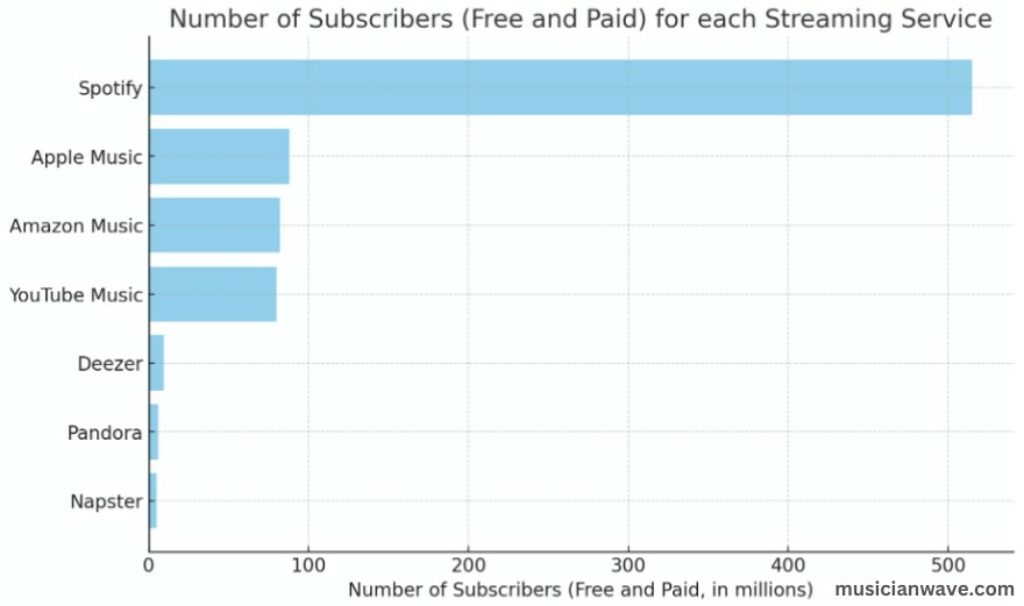
| Streaming service | Number of subscribers (free and paid) |
| Spotify | 515 million |
| Amazon Music | 82.2 million |
| Apple Music* | 88 million |
| YouTube Music ** | 80 million |
| Deezer | 9.3 million |
| Pandora | 6.125 million |
| Napster | 5 million |
| TIDAL | Undisclosed (unreliable sources point to 3 million users) |
| SoundCloud | Undisclosed (175 million total users, but mostly free users) |
Data sources:
TechCrunch [1] [2]
Rolling Stone
DMR
Statista
Appinventiv
Billboard
* Estimated figures
** Also includes YouTube Premium users.
*** Also includes some YouTube Music users.
Who’s the world’s most popular streaming artist?
According to streaming data from Spotify, the American rapper Drake is the world’s most popular streaming artist, followed by Bad Bunny and Ed Sheeran. With close to 250 tracks uploaded to the streaming platform, Drake has hit over 46.5 billion streams on the world’s most popular streaming service.
The table below shows the world’s top 10 streaming artists, their number of plays, and their estimated total revenue (in U.S. dollars).
Please keep in mind their revenue was calculated according to Spotify’s average PPS, meaning there’s a good chance they have earned a lot more.
| Artist | Number of plays | Estimated total revenue ($) |
| Drake | 46,697,543,955 | 200,799,439 |
| Bad Bunny | 35,843,162,498 | 154,125,599 |
| Ed Sheeran | 35,801,925,406 | 153,948,279 |
| The Weeknd | 31,588,739,684 | 135,831,581 |
| Ariana Grande | 30,689,233,907 | 131,963,706 |
| Justin Bieber | 30,250,265,777 | 130,076,143 |
| Taylor Swift | 28,852,695,444 | 124,066,590 |
| Eminem | 28,368,411,475 | 121,984,169 |
| Post Malone | 27,852,251,588 | 119,764,682 |
| BTS | 25,546,119,271 | 109,848,313 |
Data source:
Can artists live off streaming platforms?
Musicians like Drake and Bad Bunny have made hundreds of millions out of Spotify, but it can be challenging for smaller artists to make a living off streaming platforms. To make $1,000 every month in the highest-paying streaming service (Napster), you’d need to have more than 53,000 monthly streams.
It goes to show that, unless your music is very popular, streaming platforms alone won’t help you make ends meet. Nonetheless, Spotify and other streaming services can help you to get to more listeners. When used as a promotional tool and complemented with ticket and record sales, streaming platforms can be a viable way of making money as a professional musician.
How can artists increase their earnings from streaming services?
Releasing as many new songs as possible, getting featured in playlists, and making the most of digital marketing strategies are three excellent ways of increasing your streaming-services earnings.
Releasing more music to get to more listeners is one of the simplest strategies to make more money off Spotify, Apple Music, and other streaming services. By having more tracks online, you can increase your chances of getting into high-profile playlists. The more listeners you have, the easier it is to get to new listeners.
Speaking of playlists, it’s also essential to make sure your top tracks are getting into appropriate playlists. You can get into more playlists by enlisting the services of a music marketing company or taking advantage of promotional tools such as Spotify for Artists.
Finally, you can improve your chances of being discovered online by learning more about other music production stategies.
Which countries pay the most per stream?
South Korea is by far the country that pays the most per stream, followed by the United Kingdom and Denmark. The collective average PPS value of the United States – the world’s largest music market – falls behind the PPS value of smaller countries such as Monaco, Lichtenstein, and Luxembourg.
Listed in U.S. dollars, the table below shows how the collective average PPS value of South Korea and other top countries compares to the PPS value of the United States and other leading national music markets. With a dismal PPS value of $0.0005, Turkey sits at the very bottom of the list.
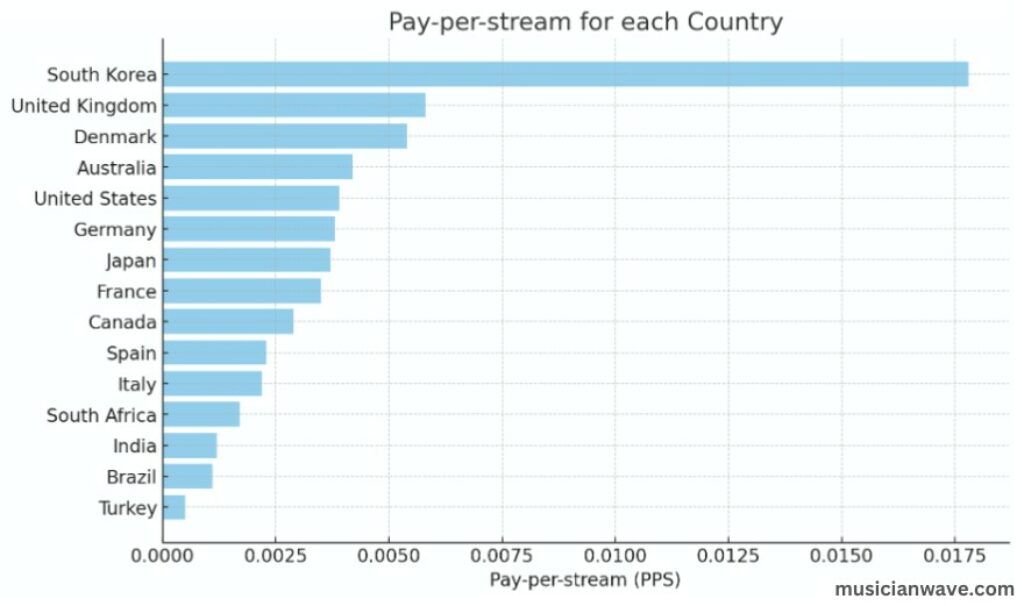
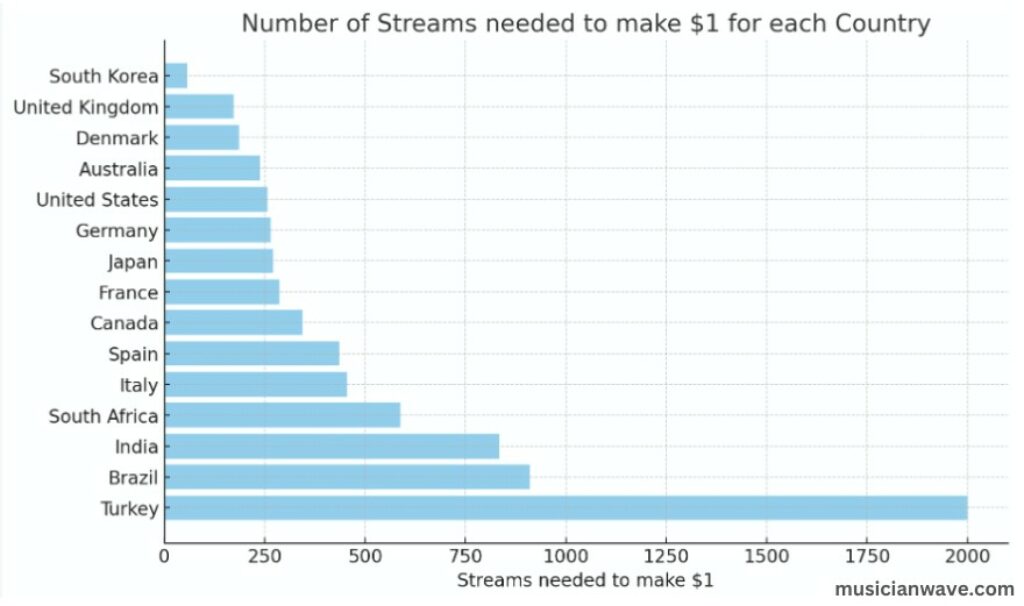
| Country | Pay-per-stream (PPS) | Streams needed to make $1 |
| South Korea | $0.0178 | 57 |
| United Kingdom | $0.0058 | 173 |
| Denmark | $0.0054 | 186 |
| Australia | $0.0042 | 239 |
| United States | $0.0039 | 257 |
| Germany | $0.0038 | 264 |
| Japan | $0.0037 | 271 |
| France | $0.0035 | 286 |
| Canada | $0.0029 | 345 |
| Spain | $0.0023 | 435 |
| Italy | $0.0022 | 455 |
| South Africa | $0.0017 | 589 |
| India | $0.0012 | 834 |
| Brazil | $0.0011 | 910 |
| Turkey | $0.0005 | 2,000 |
Data source:
Summary
There’s no black-and-white answer to most questions involving music-streaming payments. However, artists can expect to get paid less than one cent per stream in most streaming services, including Spotify. While Napster and TIDAL are interesting exceptions, they do lack the huge listener base you’ll find on Spotify or Apple Music.
PPS values can vary drastically according to many factors, including the country and type of listener tuning in to your songs or the deals you’ve made with your record label or distribution company. Nonetheless, it’s essential to take part in the ever-growing music-streaming industry to make a living as a musician.
Digital music streaming isn’t going anywhere, so make sure you’re getting in on the deal!





